
High Plains Gardening
The gardening website of the Texas High Plains Region
With over 30,000 registered cultivars, how can anyone hope to make sense of the daffodil world?Organization progressed right along with development of the many cultivars, dividing them into 13 divisions and creating a shorthand code that enables breeders and daffodil enthusiasts worldwide to easily communicate. For a cursory look at the governing bodies, learn how you can be "in the know." ('Dutchmaster' photo at right.)
Over the centuries, the organization and regulations that govern daffodil cultivars developed and evolved, changing and growing as the breeding progressed. At the Royal Horticultural Society's First Daffodil Conference in 1884, members gathered together to organize the world of daffodil cultivars. At that time, they determined the cultivar names would be "fancy names", not botanical names in Latin form, and that each name would be unique and disctintive enough from each other in order to avoid confusion. To keep track of so many names, the RHS became the International Registration Authority in 1955. Because of the distances around the world before the advent of the Internet, some name duplication occured. However, for the most part, each cultivar name is unique. There is estimated to be approximately 30,000 names of daffodil cultivars registered today. There is no charge for daffodil registration. On thing the RHS does not do as the International Registration Authority is to insure each registered cultivar is unique, only that the name is unique. It is up to the breeder to determine whether his/her cultivar is distinct enough from any other to be a new cultivar.
To establish uniformity across the world, The World Daffodil Council was established in April, 1998 to co-ordinate the activities of daffodil societies, which previously set rules and regulations. Societies from the United States, the United Kingdom, Australia, New Zealand and the Netherlands banded together in this effort. For information about the cultivar register and the cultivar database, click here. Forms for registering a cultivar can be downloaded here.
In the United States, the various city, state and regional daffodil societies are members of the American Daffodil Society (ADA), which also has members from 48 countries around the world, including from Canada, the United Kingdom, Mexico, New Zealand, Australia, Holland, Germany, Hungary, Argentina, Ireland, Italy, Japan, Latvia, Norway, Poland, South Korea, and Sweden. The Royal Horticultural Society (RHS) handles the registration for new daffodil cultivars. American member registrants are forwarded to the RHS by the ADA. (Photo at left is of a pink large-cupped daffodil with hellebores in the background.)
The American Daffodil Society “maintains an Internet-based daffodil database/query system, DaffSeek.org, and publishes several books that list and describe registered daffodil cultivars, including Daffodils to Show and Grow, which is updated approximately every four years.” Other free services offered to all by the ADA include DaffLibrary, Daffnet, and DaffTube. Their website contains a plethora of information pertaining to daffodils. They also publish an eighty page quarterly journal, The Daffodil Journal, for its members. Back issues of the Daffodil Journal for 1964 – 2015 can be accessed online by anyone here.
There is a good deal of diversity among the numerous narcissus species. Many of the wild species are short and diminutive, and are limited to yellow and white perianths, yellow and white coronas and a few poeticus species with small coronas of bright red-orange and green. In the case of red, the red-orange is only found on the rim of the corona, such as of N. poeticus and N. radiiflorus species. Through many crosses using all the species and naturally occuring hybrids and some cultivars, we enjoy cultivars today with additional colors of every shade of yellow, orange, cream, apricot, pink and red. Some daffodil perianths and coronas can start out one color and fade to another as they mature, such as yellow to cream, or pink to apricot. And pink or red daffodils can fade if grown in full sun. Breeders are trying all the time to produce a true red, and more daffodils that make show winners, cut flowers and good garden plants that return year after year.
The genus Narcissus is in the Amaryllis family, Amaryllidaceae. There are currently 70 (according to Noel Kingsbury, Daffodils) or 85 species (David Willis, Yellow Fever) of daffodils, many of which are sub-divided into numerous subspecies and varieties. Most of the daffodils planted by gardeners are cultivars, although most florist and garden bulbs are derived from relatively few species. With over 30,000 registered varieties (cultivars) through the decades, only a fraction of these cultivars are available through catalogs each year. Some cultivars are registered only for shows and many do not attract enough appeal to be commercially viable. Other cultivars go out of fashion or are susceptible to pests and diseases. I’ve seen only around a dozen offerings of the actual wild species in some main catalogs.
I use John Scheepers Beauty from Bulbs catalog (about 140 varieties available), Brent and Becky’s Bulbs (about 175 varieties) and McClure & Zimmerman (142). Old House Gardens is a retailer of heirloom bulbs. I counted 61 varieties or species in their online catalog. Another supplier is Qdaffs.US, a supplier of hard to find and sought after bulbs, quite a few of them historic. They have listed their bulbs in various categories for ease of ordering for historical collections, such as, by breeder. Qdaffs.US stops taking orders for the year on July 4th. Presemably, they sell out sooner. Additionally, there are smaller growers and breeders that offer other cultivars. I imagine many more varieties are available from the many bulb suppliers in Britain, although I’ve never ordered from a supplier outside the United States. Most bulb sellers won’t have the new crop posted until the end of May or first of June each year, which is also the best time to order. The American Daffodil Society lists most, if not all, specialty and general bulb suppliers. (Photo at right is of 'Tete e Tete', a miniature daffodil.)
There are many stories of truly significant cultivars, whose names even a casual gardener might be familiar. Such as the grand golden trumpet cultivar 'King Alfred', bred nearly 125 years ago in 1899 by a small group of market gardeners from Devon. (Photo of a Trumpet daffodil at left, cultivar unknown, a cut flower in the trade.)
In 1890, John Kendall successfully crossed ‘Emperor’ with ‘Maximus’ before he died. The actual selection and development was carried out by Walter Hill, who lived in the village of Newton Poppleford, and was employed by John’s son, Percy Kendall, owner of a market garden and florist shop nearby. Hill rented a place and bred what became a world favorite daffodil.
In 1899, Percy Kendall submitted ‘King Alfred’ to the Narcissus Committee of the RHS, and was awarded the top prize. ‘King Alfred’ was heralded “by far the best yellow trumpet.” Registered under Kendall’s name, Barr and Sons distributed the first 100 bulbs, and sold them for six guineas each.
At the death of Percy Kendal in 1910, Walter Hill took over the rights to ’King Alfred’ and became one the village’s largest employers selling ‘King Alfred’ cut flowers and bulbs across the country. Hill’s family didn’t carry on in his business, but the ‘King Alfred’ legacy remains in the village of Newton Poppleford. Even today, breeders doubt a trumpet daffodil could ever be bred to rival ‘King Alfred.’ (Brady, The ‘King Alfred’ Story.)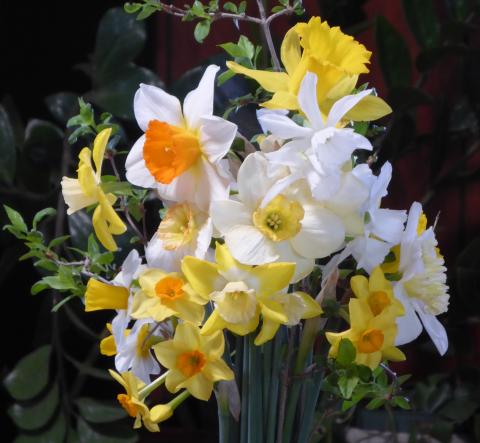
Persistence and dedication through the development of some of these dearly loved spring cultivars inspires respect for growers efforts.
In discussing daffodils, it’s good to understand only a few terms for the gardener. The petals of a daffodil are actually tepals, sometimes called sepals, and are universally referred to as the perianth. The perianth usually has six segments. The corona can be shaped as a small cup to a large trumpet. The shape of the corona is the most distinctive feature of the daffodil. (Click here for a two minute video about daffodil botany.) Daffodils for the gardener are arranged into 13 divisions, plus the miniature grouping, by type of daffodils.
As mentioned above, daffodils are divided into thirteen divisions, based on the wild species and crosses between the species. Each, if not most, of the wild species have now been used by daffodil breeders to create either cultivars or new divisions. (Kingsbury, Daffodils). In most bulb catalogs, daffodils are listed in division order as follows:
Division One Trumpet Daffodils
When we hear the word daffodil, The golden trumpet daffodil of Wordswoth comes to mind. The trumpet image is derived from N. hispanicus, N. pseudonarcissus and N. obvallaris; the last two native to or naturalized in Britian. Trumpet daffodils are early flowering with deep yellow coloring. Trumpet daffodils bear a single large flower where the length of cup (trumpet or corona) is greater than or equal to the length of the perianth segments (tepals). Their leaves are tall and wider than most as well. Trumpet daffodils can be single color, shades of one color or bicolor, in any arrangement of shades of pink, yellow, orange and white. The trumpet of bicolor daffodils are usually richer in color than the perianth, except in the case of reverse bicolors, where the trumpet is lighter or paler. Trumpet daffodils perform better in USDA Zones 7 and cooler. If your trumpet daffodils don’t return well, it might be because the climate is too warm for them. Most of the trumpet daffodils I’ve planted in the past have not returned, especially when planted in full sun. In our climate, trumpet daffodils should be planted in summer shade for a chance of returning year to year.
The winner of the Wister Award for 2021 was awarded in February to ‘Marieke’, a yellow trumpet with a record of excellent garden performance; it may be heat tolerant. 'Mount Hood' (photo at left), is another Wister award winner in the trumpet division. This year I found three still growing in a shady spot in my garden, however, I have no record of planting it. View other Wister award winners here. The Garden Notes on Growing Daffodils discusses the Wister Awards.
Division Two Large-Cupped Daffodils
Very similar to the trumpets, except that with large-cupped daffodils, the length of the corona is more than a third as long as the length of the perianth segments, but less than equal to it. An easy way to tell if it’s a trumpet or large-cupped daffodil is to fold one of the perianth’s down to the trumpet to see if the trumpet equals/+ the perianth or not. Large-cupped daffodils provide an very large selection with roughly 45 percent of registered cultivars, and are good for picking, perennializing, and as a show flower. One of the naturalized daffodils in Great Britain is N. pseudonarcissus, also known as the false daffodil or “bastard daffodil,” presumably because it didn’t look like the poet’s daffodil, N. poeticus or N. tazetta, from the eastern Mediterranean region.
Large-cupped daffodils originated from the cross of trumpet species, chiefly N. hispanicus, with N. poeticus. This cross gave large-cupped daffodils greater heat tolerance, the color red or red-orange, and a wider bloom range across the division. Two the the best selling dafodills are large-cupped -- the yellow 'Carlton' (photo at right) and bi-color 'Ice Follies' (photo at left), both long lived my garden.
Large-cupped daffodils have one flower to a stem. Coloring is similar to the trumpets, but more of them with orange-red cups than the trumpets due to crosses involving the red pigment in the corona of N. poeticus. They are less sensitive to heat than the trumpets (inheriting genes from a warmer climate species), therefore, may be a better choice for warm climates. If you’re a trumpet fancier where it’s warmer, choose a large-cupped daffodil with a larger trumpet. The difference between Division 1 and 2 is often a matter of millimeters. ‘Carlton’, ‘Golden Salome’, and ‘Saint Kerverne’ are three with trumpets almost as long as a Division 1 Trumpet daffodils.
Division Three Small-Cupped Daffodils
Small-cupped daffodils have cups that are less than one third the length of the perianth segments, and came about by crossing large-cupped cultivars with N. poeticus. Thus, this grouping has many strongly colored coronas with modest cups and white or pale perianths while retaining heat tolerance and a wider bloom range. Coronas can be rimmed, where the outer edge flares outwards, with a distinctive colored rim, or not. Small-cupped daffodils are one flower to a stem, flowering early, mid or late season, depending on the cultivar, mostly mid to late season. Good perennializer and show flower. Slight spicy fragrance.
'Merlin' (Lionel Richardson, 1936 with a bright reddish rim), 'Dreamlight' (Guy Wilson, 1934, photo on the right) and 'Barrett Browning' (Lefeber, before 1945, Dutch) are three small-cupped daffodils that are Wister award winners and are most attractive. By the time the majority of small-cupped daffodils bloom, other foliage is up and growing to accompany the look. I'm personally atracted to this division because of the white perianths that show off vivid coronas.
Division Four Double Daffodils
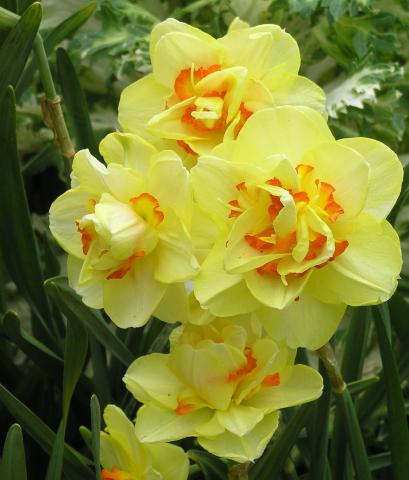 This division contains all the double daffodils. Either the perianth segments, the corona or both parts are doubled, with one or more flowers to a stem, flowering early, mid or late season, depending on the cultivar. Breeders aim for either a real curiosity, with perianth and petaloids bunched up and bicolor, or doubles where the doubled perianth segments are artfully arranged. (Photo of a double on the left.) The first doubles are the result of natural mutations among various species, and have been around in gardens for centuries. Up until the early 20th century, doubles were rare. It was not known that any doubles could develop seed, until the chance notice by J. Lionel Richardson of a seed pod forming in one, a “Mary Copeland’ cultivar, which produced fertile seed of a double cultivar he called ‘Falaise’. It’s history is lovingly recounted:
This division contains all the double daffodils. Either the perianth segments, the corona or both parts are doubled, with one or more flowers to a stem, flowering early, mid or late season, depending on the cultivar. Breeders aim for either a real curiosity, with perianth and petaloids bunched up and bicolor, or doubles where the doubled perianth segments are artfully arranged. (Photo of a double on the left.) The first doubles are the result of natural mutations among various species, and have been around in gardens for centuries. Up until the early 20th century, doubles were rare. It was not known that any doubles could develop seed, until the chance notice by J. Lionel Richardson of a seed pod forming in one, a “Mary Copeland’ cultivar, which produced fertile seed of a double cultivar he called ‘Falaise’. It’s history is lovingly recounted:
“The year was 1929 and the sight of a swelling seed pod on the normally infertile ‘Mary Copeland’ was so unusual as to arouse Richardson’s considerable interest. Consequently, the plant was most carefully tended during the further development of the seed pod, the stem bearing it being immediately secured to a stout cane. The Cross Book shows that the pod eventually gave rise to eight seeds, which were gathered and sown as soon as they ripened on 11 July 1929. These eight seeds produced six seedlings, one of which was to become ‘Falaise’.” ( Willis, Yellow Fever )
Because ‘Falaise’ was scented and with some dark red orange perianth segments, it is speculated a bee first visited a N. poeticus. Richardson went on to cross this with many daffodils in many divisions and colors. The doubles race was on.
Previous to studying about daffodils, I had negative feelings towards the doubles and split corona daffodils and decided not to include them in my garden. But the description of ‘Falaise’ and development of doubles in David Willis’ book, Yellow Fever, was so fascinating, I am now highly tempted to plant some doubles, a clump each of white perianth (perhaps the heirloom ‘Cheerfulness’), one clump of yellow (‘Tahiti’) and maybe even the heirloom, ‘Albus Plenus Odoratus’, in remembrance of many early historic gardens. Or perhaps ‘Sir Winston Churchill’, the recipient of the 2020 Wister Award, a scented double with white perianth and orange corona that averages 4 flowers per stem. I have much more regard for doubles after learning of the dedication of Copeland, Richardson and those daffodil breeders who came after.
Division Five Triandrus Daffodils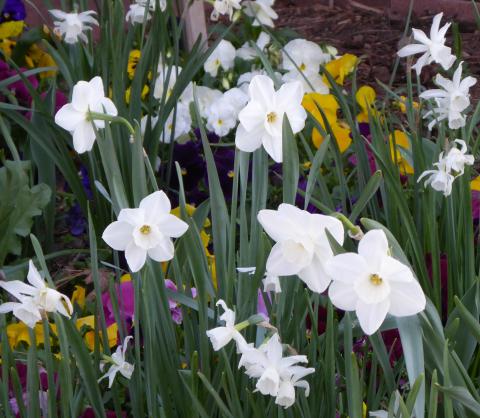
Any of the daffodils after Division Four are referred to as the “upper divisions”. Likewise, most people are more likely to refer to them as narcissus, rather than daffodils. Either is correct. With the fifth division, we depart from the "traditional" daffodils one might see planted in parks or at the florists. These are often smaller, with different proportioned heads and with more than one flower per stem.
Triandrus daffodils are descended from Narcissus triandrus, an Iberian species. A distinct bell shaped cup and two or more flowers per stem that point downward are notable characteristics. They are known to be more short lived, preferring acidic, moist soils. However, cultivars crossed with other species may be longer lived. Triandrus daffodils are somewhat fragrant and have a delicate and modest appearance where the perianth segments are reflexed; they do well in containers. 'Hawera', a miniature daffodil, and 'Thalia' (in the photo at the right, 'Thalia' is the small white daffodil) are both Wister award winners.
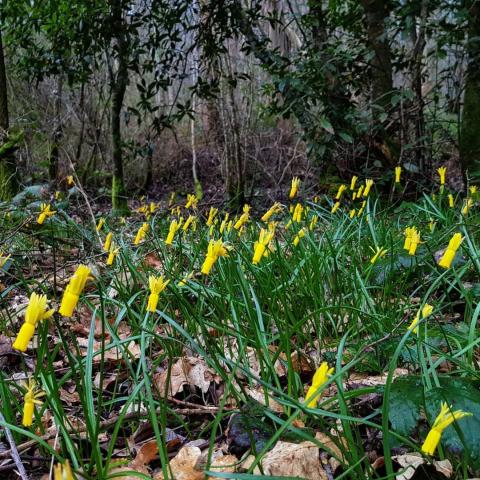
Division Six Cyclamineus Daffodils
Cyclamineus daffodils are earlier and smaller flowering daffodils, one flower to a stem; perianth segments significantly reflexed with the flower at an acute angle to the stem and a long narrow trumpet. I have always found the windswept appearance of the perianth attractive, a flower with its hair streaming back, giving the impression of a wild spirit riding in an open-topped race car. They descend from Narcissus cyclamineus, native to northwest Portugal and Spain along moist riverbanks, photo at left.
Its name is derived from the cyclamen’s reflexed petals and drooping flowers. Cyclamen daffodils are excellent for forcing, and in containers, are more tolerant to shade and moisture than others. Mostly early mid-spring blooming. 'Rapture', a Grant Mitsch cultivar from 1976, is a very early bloomer and the only Division 6 Wister award winner. 'February Gold' and 'Jetfire' are two other popular cyclaminius daffodils.
Division Seven Jonquilla Daffodils
These are the jolly jonquils oft planted in the American South, due to their heat and summer rain tolerance. One can frequently find clumps of jonquils at cemeteries and abandoned home sites in the South. Jonquil daffodils bear one to five fragrant flowers per stem, perianth spreading or reflexed. Their foliage is reed-like or rush-like, and have been called the “rush daffodil”. The name Narcissus jonquilla itself is “derived from the Spanish vernacular name jonquillo, meaning ‘little rush’” (Willis, Yellow Fever). I like the jonquils, because of the narrowness of their leaves – less unsightly once the flowers have finished. Jonquils are also great in containers, generally blooming in mid to late spring at a time when other foliage is up in the garden.
N. jonquilla is native to Portugal and Spain in sandy and rocky soils along rivers. 'Hillstar', a Grant Mitsch cultivar (photo at right) and 'Golden Echo', a Heath cultivar, are two of the nine jonquil daffodils that are Wister award winners.
Division Eight Tazetta Daffodils
Tazetta daffodils (N. tazetta) are truly fragrant daffodils, bearing three to as many as twenty-thirty flowers per stem flowering mid to late season, with perianth segments spreading, not reflexed. The leaves of tazettas are broad. The name tazetta means little cup, referring to the shape of the corona. Historically it is known as Polyanthus Narcissus – having many or multi-flowered stems.
Tazetta daffodils were the first of the daffodils to be cultivated. Having long been in cultivation, its habitat origins are unclear, however, it is thought to be “native along coastal areas, streams and moist meadows in Spain, Portugal, the Canary Isles, in north Africa from Morocco to Libya, southern France, Italy, Corsica, Sardinia, the Balearic Isles, Sicily, Greece, and also in coastal areas of Syria, Lebanon, Israel and Cyprus” (Willis). In other words, along most of the coast of the Mediterranean Sea. From there, it was transported into China where it’s known as the Chinese Sacred Lily, and Japan where they have perennialized in some areas.
Tazettas are known for forcing, as early as mid-winter for the Western Christmas holidays, and the Chinese New Year. When we think of the tazetta’s fragrance, it is the the strong fragrance of the ‘Paperwhite’ narcissus, N. papyraceus, the cultivar commonly forced in late fall, we remember. In the garden in springtime, other cultivars do not appear quite as strong, though strong. Tazetta daffodils are a good choice for areas with hot summers. There is a N. tazetta ssp. aureus, meaning gold flowering, from which the rich gold cultivars doubtless originates. 'Falconet' (a Grant Mitsch cultivar, 1979), and 'Geranium' (photo at right, van der Schoot, prior to 1930) are two big award winners, including the Wister award in the United States.
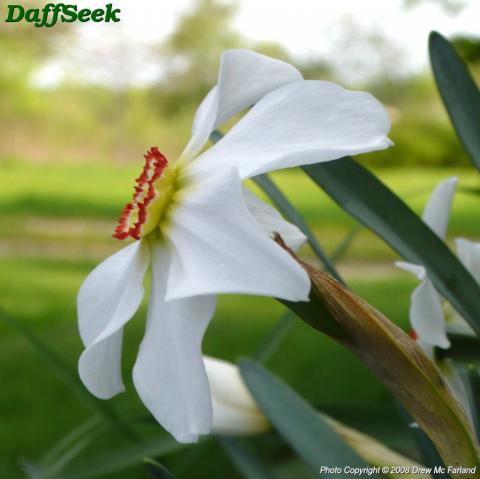 Division Nine Poeticus Daffodils
Division Nine Poeticus Daffodils
Including the poet daffodils (N. poeticus) in one’s garden not only extends the daffodil season, it naturally lifts it’s spring atmosphere, it has such a high brow name -- who wouldn’t want a poet blooming in their garden. This division contains the least number of cultivars. The poeticus daffodils are among the tallest of the daffodils, up to 20 inches, and the latest to flower. One flower to a stem, pure white perianth, corona very short or disc-shaped, not more than one-fifth the length of the perianth segments; corona usually with a green and/or yellow center and red rimmed, but sometimes wholly or partly of other colors. Their flowers are fragrant. The most common cultivar to be found in plant catalogs is called 'Pheasant Eye', N. poeticus ssp. recurvus. (photo at left from Daff.seek) The poeticus daffodils are half of the crucial cross in producing cultivars in the large and small-cupped daffodil divisions. The poeticus half of these crosses provides height, heat tolerance, a later flowering and the reddish color of many cultivars.
The poet daffodils are found in the countries on the northern side of the Mediterranean, including from moist meadows near sea level in southern France to the high mountains of central Europe, Pyrenees, Swiss Alps and the Balkan mountains, and south to Greece. N. poeticus var recurvus’ natural range is further north in Switzerland and France in the eastern Pryenees; and N. poeticus hellenicus is restricted to Greece, and other species into southeastern Europe, even to Ukraine. Only the narrow-leaved narcissus, N. angustiformis, grows wild in Ukraine, in the mountains of Transcarpathia (the Narcissus Valley in the Carpathian Biosphere Reserve). It is now so rare that it has been listed in the Red Data Book of endangered species, surviving since the post-glacial period. 'Actaea' is a Wister award winner, dating back prior to 1919 from the Dutch breeder, G. Lubbe and Sons.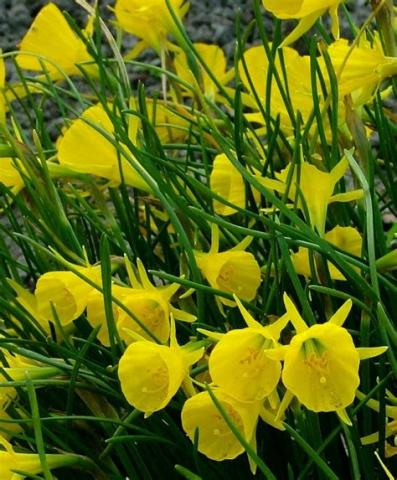
Division Ten Bulbocodium Hybrids
I think the most unusual looking daffodils are the Bulbocodiums, also known as the “Hoop Petticoat.” It’s a division with very few cultivars, although it is recently a focus of breeding. Bulbicodium daffodils have minimal perianth segments and a greatly expanded cup, almost a distortion, or reverse, of the classic daffodil. Genetically, the Bulbicodium species are thought to be the youngest of the daffodils, and have a wide chromosomal range among its species. The various species and subspecies are found growing primarily in Spain and Portugal, a few species in Morocco and Algeria.
Most of the Bulbocodiums are short, anywhere from 6-8 inches, and mostly one flower per stem. Some are lightly fragrant, blooming in early spring, in yellow or white. There is good variety in their leaves. Some species with a single thin leaf, others with two leaves, one species with five or six, and one with grass-like leaves. Bulbocodiums are commonly grown in alpine or rock gardens, or in containers. (Photo at right is Bulbocodium "Golden Bells' from John Scheepers.)
Division Eleven Split Corona Daffodils 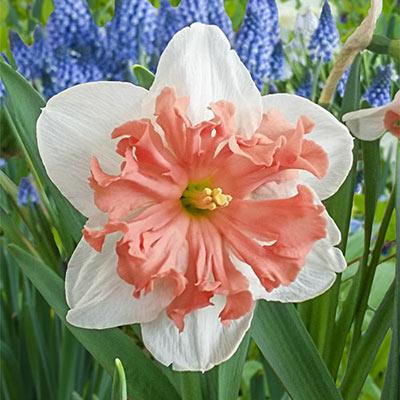
Split corona daffodils, are sometimes also called split-cupped, but more often by less complimentary names, although they do have appeal to some. Split-corona or split-trumpet, development is sometimes called reverse evolutionary development: “The prominent corona (trumpet or cup) which most of us recognize as the main distinguishing characteristic of daffodils is, in evolutionary terms, a relatively modern development. In the most primitive species, it exists as no more than a low rim of six small scales. In many of the more developed species, the corona consists of six clearly defined lobes, leading to the conclusion that at an earlier stage of evolution it may have been completely fused to form the characteristic, entire corona that we know today. The recent development of split corona cultivars is, therefore, something of a reversal of the evolutionary trend that has occurred within the species.” (Willis, Yellow Fever.) Interesting.
Not too unlike the development of double daffodils, split coronas came about by chance experimentation. A Van Reen cultivar of 1897, “ ‘Victoria’, nowadays rather rare in gardens, was described in Christopher Bourne’s catalogue in 1913 as having a “large trumpet, rich yellow, flanged and frilled”, making it in flower shape at least not too dissimilar to fimbriatus [or fringed].” From that cultivar, much crossing was done over time to obtain today’s modern split-corona daffodils, for those who fancy them. The more I look at them, the more I like them. Split-coronas adds significant interest and novelty to daffodil bouquets. (Photo at right is 'Shrike' from van Bourgondien catalog.)
This division is split into three groups, the collar, papillon and combination daffodils – depending on how the corona is split. Split-corona daffodils bloom from early-mid spring to mid-late spring, and grow between 10 – 18 inches tall (usually 14-16”) depending on the division of daffodil used in the cross, and in many color combinations.
Division Twelve Miscellaneous Daffodils
Consists of daffodils not falling into any of the previous categories. Many are inter-division hybrids. A catch-all for daffodils that defy categorization. ’Tête-à-Tête’ is the most notable daffodil in the miscellaneous category, developed by Alec Gray prior to 1949. It is a Wister award winner, among several other awards.
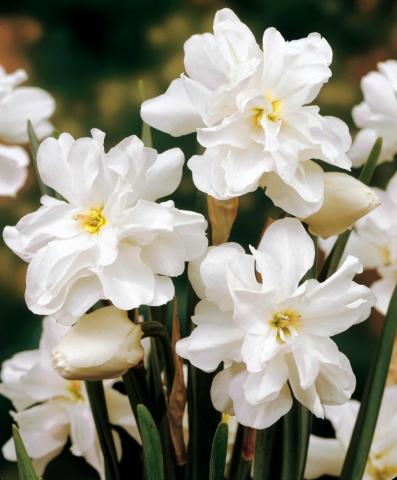 Division Thirteen Natural Species, Variants and Hybrids
Division Thirteen Natural Species, Variants and Hybrids
This division includes all the wild species, their natural forms and naturally occurring hybrids. Included in this division are some of the heirloom daffodils mention in the the first Garden Notes on daffodils in early English, Colonial and early American gardens. Such as ‘Albus Plenus Odoratus’ ( the double 'Pheasant's Eye', photo at left from John Scheepers) and N. x odorus ‘Plenus’. Daffodil species that grow in close proximity to each other can and do hybridize, some producing viable seed, others only increasing by vegetative bulb clumping. Division Thirteen also includes Narcissus viridiflorus, an autumn, green blooming daffodil – one of the most unique of the genus.
N. poeticus recurvus and N. obvallaris (The Tenby Daffodil) are Wister award winners. The Tenby daffodil (also known as N. pseudonarcissus ssp. obvallaris,) is a small golden daffodil with a long trumpet, native to Great Britain and was thought to be extinct due to over harvesting, but found growing near Tenby. It is the national flower of Wales.
Miniatures are not a division of its own, and are normally listed at the very end of daffodil lists in catalogs. Officially, miniatures have the same descriptive divisions as standards, only with smaller blooms, usually less than 2 inches in diameter. Some catalogs show miniatures with a flower size of 1 inch or less. They are mostly between 3 and 10 inches tall, the majority offered grow 4-6 inches tall.
Miniatures mainly are combinations of yellows and whites, but have a range of bloom times from very early spring into late spring. Because many wild daffodils are small and the miniature group can contain daffodils from all divisions, it is quite an interesting group. Miniatures that are Wister award winners are ’Tête-à-Tête’, 'Sun Disc', 'Kokopelli', and 'Segovia', (Photo at left, unknown miniature.)
Many gardeners have small gardens, or can only grow plants in containers. Breeders are responding by breeding smaller plants across the board, including daffodils. Look for more miniatures in the future.
If one peruses enough catalogs featuring daffodils, they will notice a shorthand code after the cultivar name. The American Daffodil Society and Royal Horticultural Society use a simple code to provide shorthand descriptions of daffodils.
The daffodil division is listed first as a number from 1 – 13. Then there are at least two letters that refer to the daffodil’s colors. The letter or letters before the hyphen describe the colors of the petals (also known as the perianth), starting from the tips. The letters that come after the hyphen are the colors of the trumpet or cup (also known as the corona), starting from the base. The corona can be comprised of up to three colors. In the code, the colors are recorded starting from the base of the corona, moving outward to the rim.
Y = yellow, W = white, O = orange, R = red, G = green, P = pink
An example is ‘Goose Green’, a small-cupped daffodil (third division) listed as 3 W-GYR
3 = a small-cupped daffodils; W = with white perianth; and GYR = a cup that’s green at the base, yellow in the middle and red at the rim.
Another example, the large-cupped daffodil ‘Avalon’ with a yellow perianth and white trumpet is 2 Y-W, and the coding for a more complicated Jonquilla ‘Hillstar’ with a yellow to white at the base perianth and yellow to white at the rim of the corona is 7 YYW-YWW (photo at left).
It took patient work over decades to unlock and develop traits that weren’t at all visible in the wild species. Large-cupped daffodils is a prime example, crossing the early trumpet daffs with the latest blooming daffodils, the poeticus, was a tremendous achievement. Pollen had to be held over weeks from N. hispanicus or P. pseudonarcissus until poeticus bloomed. This accomplishment gave the world a wider range of colors, more heat tolerance and longer stems, as well of an array of daffodils in the mid-season. This was followed up to produce small-cupped daffodils, again with crosses of large-cup cultivars and poeticus to expand the range. And then the development of the pinks, doubles and split corona daffodils, making available an unimagined range of cultivars available to us today with just a click.
When I see these flowers blooming in the springtime, I’ll allow my mind to wonder off to distant lands, visualizing their forebears growing along the rivers and streams, up mountain valleys from Spain, France, Switzerland and into the Narcissus Valley of Ukraine. And I’ll remember daffodils as they were used by former civilizations in not just important life rituals, but also for their pure enjoyment, much as we do today. (Photo of unknown large-cup daffodil with red camellias in the background.)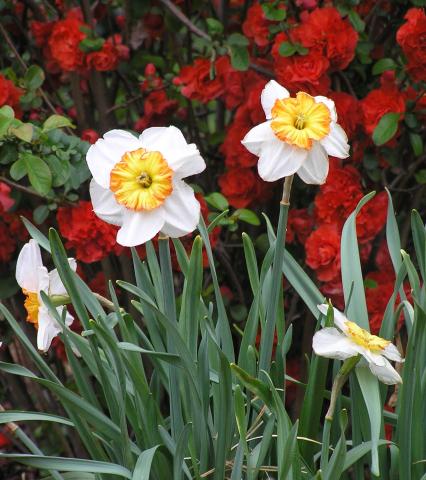
Read the first article, The World's Most Popular Spring Flower -- Daffodil.
Read the third article in the Daffodil Series, Growing Daffodils in the Texas Panhandle.
American Daffodil Society Informative website about all things daffodils.
Brady, Rose. The ‘King Alfred’ Story, The Daffodil Society (Great Britain), 1999.
Gripshover, Mary Lou. Daffodils, Regional Proven Performers, The American Gardener, March/April 2011.
Kingsbury, Noel. Daffodil the Remarkable Story of the World Popular Flower, Timber Press, 2013.
Heath, Brent and Becky, Daffodils for American Gardens, Bright Sky Press, 2001.
PHS Daffodils, supplier of showy and unusual bulbs.
Willis, David. Yellow Fever, A Prospect of the History and Culture of Daffodils, Privately Published by the author, 2012. An eBook in the DaffLibrary.
Angie Hanna, March, 2021©